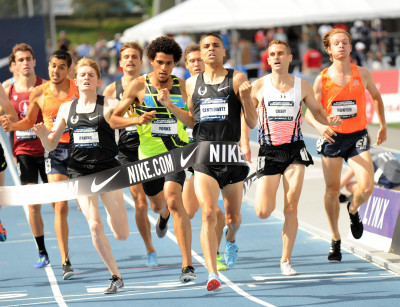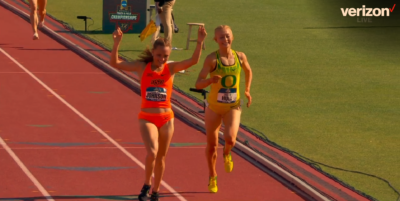Will PPV Work? How Will Centro Look? 6 Big Questions Ahead of 2021 Sound Running Track Meet
By Jonathan Gault
May 13, 2021
The 2021 track season is heating up. In recent weeks, some of America’s top stars have been gearing up for the Olympic Trials at events like the USATF Grand Prix and USATF Golden Games, and there’s another loaded meet on tap this weekend in California: the Sound Running Track Meet, which doubles as the first installment of the 2021 American Track League outdoor season.
The Track Meet is basically taking the place of Payton Jordan, which was cancelled this year, with super deep distance fields led by the likes of Sifan Hassan, Lopez Lomong, Matthew Centrowitz, and Laura Muir. A nice bonus: there are some decent sprint fields as well, including world leader Trayvon Bromell in the 100 and a loaded men’s 110 hurdles featuring Devon Allen, reigning US champ Daniel Roberts, and the last two Olympic champs in Aries Merritt and Omar McLeod.
The Track Meet is also trying something new from a broadcast perspective. Though the sprints and the top heats of the 800 and 1500 will be shown live on ESPN (2-3:30 p.m. ET on Saturday), the remainder of the meet (Friday and Saturday night) will be shown pay-per-view: a one-time payment of $5.99 gets you access to everything, with all PPV revenue going to the athletes after production costs are covered.
With just five weeks to go until the US Olympic Trials kick off in Eugene on June 18, there are still plenty of questions that need answering. Here are the six biggest I have going into this weekend’s meet.
Meet details
What: 2021 Sound Running Track Meet
When: Friday, May 14 – Saturday, May 15
Where: Los Angeles, Calif.
*Schedule, entries, & results *TV/streaming information
1) How many people will pay to watch this meet?
I’ve long heard complaints from track fans who don’t like signing up for a monthly subscription to FloTrack ($29.99) or RunnerSpace ($12.99) just to watch one race. A number of them told me paying for track isn’t the issue; it’s the way the sport is structured.
Let’s say there are three meets in a given month that you want to watch, but one is on FloTrack, one is on RunnerSpace, and one is on Peacock ($4.99/month). If you wanted to watch those meets, you’d have to sign up for a monthly subscription to each service — and remember to cancel by the end of the month — and it would run you a total of $48. Now let’s say those meets were all shown on PPV. Even at $10 a pop, the customer would only end up paying $30, a savings of 38%.
I’m not saying the entire sport needs to shift to a PPV model. But the PPV experiment this weekend is interesting to consider in the wake of Jeff Merrill‘s article in Tempo Journal, in which he explains why the Track Meet will charge viewers $5.99 to watch. The passage below, during which Merrill discusses the streaming options for last summer’s Big Friendly series in Oregon, stood out to me:
I excitedly called Pete Julian, coach of the elite Nike racing team we had been working with and told him that we had a plan to film and produce the meets ourselves and then push them through the aforementioned streaming company’s platform. A brief moment of silence met my comment followed by: “We don’t really like that model.” This took me by surprise. I fully expected him to be as excited as I was about the team’s dogged determination and MacGyvering abilities. “Why not?” I asked. His response went something like this-
“Say that we have some of the best athletes in the world running these meets and the meets are behind a paywall facilitated by the streaming company. The best athletes in the world are the reason that people are tuning in and they don’t see any of that money, and on top of that, their moms have to pay to watch them race.”
It’s something I never considered before. When the NFL and NBA sign billion-dollar broadcast contracts, the players are guaranteed a piece of that pie thanks to collective bargaining agreements. But track & field has no collective bargaining agreement. The better comparison is a sport like golf or tennis, where major tournaments share broadcast revenue with their players through prize money. Some track meets are like that, but, as Julian says, sometimes there are meets with zero prize money that are nevertheless placed behind a paywall.
The big question is whether there is suitable demand for the PPV model to take hold in track & field. I’m sure a number of people will shell out $5.99 to watch the Track Meet this weekend. It’s a new and exciting concept, and people like new and exciting. But will enough people consistently pay to watch track meets at a price point that covers broadcast costs and builds a fair prize purse for athletes?
I don’t know. But I am interested to find out, and we’ll start to get answers this weekend.
2) How does Centro fare in the 1500?
For most of the year, I’ve taken it on faith that Matthew Centrowitz will earn one of the US’s three Olympic 1500 spots. He’s the greatest US miler of his generation, perhaps of all time — it’s either him or Jim Ryun — and has made every US team dating back to 2011. Yes, he’s dealt with a series of injuries ever since winning the Olympic title in Rio, but he always gets it done at USAs. Surely the reigning Olympic champ will be in Tokyo to defend his title?
I still believe that, but we’re nearing the time where Centro has to start proving his fitness. Since the 2019 World Championship final, where he ran 3:32 to finish 8th (top American), Centro has run five races (excluding the silly ones he jogged for contractual reasons). His times in those races: 3:57, 1:50, 13:32, 3:40, and 1:50.
Saturday’s 1500, then, will be a key indicator. Henry Wynne and Johnny Gregorek just ran 3:36 last weekend at Mt. SAC and are both entered. So are 2020 US indoor champ Josh Thompson and Eric Avila (3:37 at Mt. SAC). These are the guys Centro needs to be beating if he is to make his third Olympic team next month in Eugene. How does he fare against them, with five weeks to go?
3) Is Conner Mantz a threat to make the Olympic 10,000 team?
There are a few elite runners in the 10k on Friday night — Patrick Tiernan, Joe Klecker, Morgan McDonald. There are a couple of 2016 Olympians trying to show they’re still contenders (Hassan Mead, Leonar Korir). But the guy I’m most interested in is BYU’s Conner Mantz.
The last time we had an American NCAA cross country champion was Galen Rupp back in 2008. Rupp made the Olympics five months before winning NCAA XC, and seven months later, he won his first of eight straight US 10,000m titles. The US 10k team was easier to make then than it is in 2021, but it shouldn’t be understated how impressive Mantz’s NCAA XC performance was. On a brutal Oklahoma State course, Mantz utterly destroyed a loaded field, winning by 22 seconds in 29:27. Here are the pbs of the top 10 at NCAA — all of whom Mantz beat convincingly — along with their times/places at NCAA XC.
| Place | Name | School | Time | PBs |
| 1 | Conner Mantz | BYU | 29:26 | 13:24/28:07 |
| 2 | Adriaan Wildschutt | Florida St | 29:48 | 13:28/28:25 |
| 3 | Wesley Kiptoo | Iowa St | 29:54 | 13:21/27:37 |
| 4 | Nico Young | NAU | 29:58 | 13:24 |
| 5 | Patrick Dever | Tulsa | 30:00 | 13:28/28:28 |
| 6 | Blaise Ferro | NAU | 30:02 | 13:31/27:56 |
| 7 | Abdihamid Nur | NAU | 30:05 | 13:26/27:47 |
| 8 | Isai Rodriguez | Oklahoma St | 30:08 | 13:41/28:08 |
| 9 | Luis Grijalva | NAU | 30:10 | 13:16 |
| 10 | Danny Kilrea | Notre Dame | 30:11 | 14:11/28:34 |
So could Mantz, who ran 13:24 for 5,000m in April, make the US 10,000m team this year? To do that, he’d first need the Olympic standard of 27:28.00. With several professional studs in the field on Friday, the opportunity is there.
But 27:28 is really freaking fast. Only two collegians have ever run faster — Sam Chelanga ran 27:08.39 in 2010, and Cam Levins ran 27:27.96 in 2012. That’s it. The top time by an American collegian is Chris Derrick‘s 27:31.38 from 2012. Even factoring in that Mantz is better at the 10k than 5k, 27:28 is a significant step up from the 13:24 Mantz just ran, which World Athletics’ scoring tables says is worth 28:07 for 10k.
That said, Iowa State’s Wesley Kiptoo — whom Mantz smoked at NCAA XC — ran 27:37 back in December. Is it crazy to think Mantz could run 10 seconds faster? We’ll see. But if Mantz does hit the standard — one which only six Americans currently have — he’s a threat to make the team in Eugene.
4) What is Sifan Hassan doing here?
I’m curious why a woman who, based on her pbs at 1500 and 10k, could probably break the 5k world record of 14:06, is racing the 5k here against a field where the next-fastest woman is Vanessa Fraser (14:48 pb). But maybe it’s as simple as Hassan hasn’t raced since February and needs to open her outdoor season somewhere. Anything other than a convincing Hassan victory would come as a big surprise, but it will be worth seeing how American Olympic hopefuls Fraser, Emily Sisson, Emily Infeld, Rachel Schneider, Marielle Hall, and others stack up against each other.
5) Can Sinclaire Johnson make a statement?
I’ve had high expectations for Johnson ever since she ran 4:05 — the #2 time in collegiate history — to win the 2019 NCAA title. She then chopped another two seconds off that pb at USAs that year and looked to be a major contender for the 2020 Olympic team. Since then, we haven’t really seen Johnson unleash her significant talent. She raced just three times in 2020, and after moving to Portland and joining the Bowerman Track Club, she has yet to post a statement race.
That’s not to say that Johnson, 23, has been running poorly. She just missed out to teammate Gabriela DeBues-Stafford (3:56 pb) in a tactical race at the Texas Qualifier in February. A week later, she beat a solid field at the Sound Running Invite in 4:05. Most recently, she ran an 800 pb of 1:59 last week at Mt. SAC. All strong runs, but nothing that will strike fear into her fellow US 1500 runners.
The time has come to change that. With a deep field assembled at the Track Meet — Johnson’s old NCAA rival Jessica Hull, plus Dani Jones, Shannon Rowbury, Cory McGee, Emma Coburn, and Jemma Reekie — this race should go quickly. And if Johnson is to make a competitive US women’s 1500 squad this year, it’s a field she should probably be beating. Can Johnson make a statement on Saturday?
6) Is Lopez Lomong still the man?
Lopez Lomong left the 2019 US champs as the king of US distance running. He went on to run pbs of 13:00 and 27:04 later that year, the latter good for 7th at Worlds and #3 in US history. In 2020, he lowered his 5k pb to 12:58, becoming the ninth member of the US sub-13:00 club. Even at 36, he looked to be a strong bet to make the US Olympic team entering 2021.
The only issue is that while his teammates were out crushing fast times this winter, Lomong was conspicuously absent. That’s not necessarily a problem — after all, Lomong already has the Olympic standards in the 5k and 10k — but the longer one refrains from racing in an Olympic year, the more everyone wants to know why aren’t you racing? With Lomong making his season debut in the 5k on Saturday night against a decent (but beatable) field — Ben True figures to be his biggest competition — plenty of eyes will be checking to see whether Lomong remains the dominant force in US distance running.



